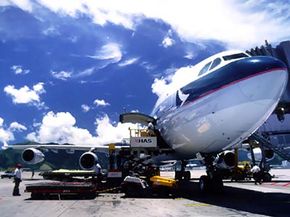Passenger Airline Freight
Just about every passenger flight is carrying some freight along with the passengers and their baggage. The U.S. Postal Service alone leases space on 15,000 of the approximately 25,000 scheduled passenger flights each day. Commercial airlines make about 5 to 10 percent of their revenue from hauling freight.
When a package ends up on your flight, airlines usually consolidate it with other packages and freight and pack them into special containers that fit in the storage area under the passenger compartment. For instance, a Boeing 747-400 (one of the largest passenger planes) can hold 416 passengers along with 5,330 cubic feet (150 m3) of cargo. That's about as much cargo as can fit in two semi-truck trailers.
Advertisement
Most of the freight gets stored in special containers shaped to fit themselves to the inside of the cargo hold. Some of the freight is also put on pallets, and loose items may end up in any open spaces that remain.
In "Combi" mode, the 747-400 will reserve some of the passenger compartments to store freight. In this mode, the plane can carry more than 10,000 cubic feet (283 m3) of cargo and 266 passengers.
And it can hold a lot more cargo when configured as a dedicated cargo plane.
